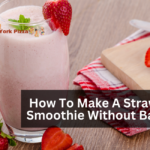Vanilla pudding is a classic and cherished dessert renowned for its rich, creamy, and comforting taste. But what if you could infuse this timeless dessert with a hint of the tropics? Coconut extract added to vanilla pudding is the answer. This article will investigate the exciting world of combining these two flavors and give you ideas, tips, and insights for creating a delightful and unique dessert experience.
Can You Add Coconut Extract To Vanilla Pudding?
Absolutely, coconut extract can be used to enhance the flavor of vanilla pudding. Adding coconut extract to vanilla pudding gives it a delightfully tropical flavor. To accomplish this, prepare your vanilla pudding per usual and add coconut extract progressively. This enables you to control the intensity of the coconut flavor, ensuring that it is perfectly balanced with the vanilla. The result is a dessert that combines the warmth of vanilla with the sweetness and slightly nutty flavor of coconut, resulting in a unique and delectable treat that will surely please your taste receptors.
Homemade Coconut Dessert
This creamy, flavorful, sweet, and delectable Homemade Coconut Pudding is incredibly simple, prepared in a single pan, and whipped up in minutes. Ideal for breakfast, snacking, and dessert.
Time
- Cook Time: 10minutes
- Total Time: 1hour Hour 10minutes
Ingredients
- 2 Cups Milk
- 1/2 Cup + 3 Tbs Sugar
- 3 Tbs Cornstarch
- 1/4 Tsp Salt
- 1 Eggs
- 1 Egg Yolks
- 2 Tbs Butter
- 1 Tsp Vanilla Extract
- 1 Tsp Coconut Extract
- 1/2-3/4 Cup Shredded Sweetened Coconut
- Whipped Topping Optional
- Toasted Coconut Optional
Instructions
- Add milk, sugar, cornstarch, salt, an egg, and an egg yolk to a large saucepan.
- Continuously whisk until viscous and bubbling over medium-high heat.
- Remove from heat and stir in the butter, coconut, and vanilla extract until the butter has melted.
- Stir in coconut until evenly dispersed.
- Cover the pudding with Saran Wrap and refrigerate until it has cooled.
- Serve with a topping of caramelized coconut and whipped cream.
Tips And Tricks
Why isn’t our egg mixture tempered? There is no logic or reason for this; we are not adding eggs to a hot liquid; instead, we cook them all at the same temperature, preventing the eggs from cooking and using them as a thickener.
If you are a devotee of coconut, begin with 1/2 tsp of coconut extract and gradually increase the amount. People enjoy a variety of coconut flavors, so I recommend starting with a modest amount, though we prefer 1 tsp.
Using Saran Wrap to cover your pudding prevents a film from accumulating on its surface.
When coconut is stirred into a dish while still warm, it becomes slightly less stiff, which we appreciate.
We enjoy toasting coconut and sprinkling it on top, as it adds a little additional flavor; however, if you prefer, you can simply use shredded coconut.
How To Store Leftover Of Homemade Coconut Pudding?
Cool It Down: Before storing, let the homemade coconut pudding settle to room temperature. This prevents condensate from forming inside the storage container, which can alter the texture of the stored item.
Use an Airtight Container: Transfer the pudding to an airtight container with a tight-fitting lid. A container with a secure seal helps prevent air and moisture from entering, which can cause skin to form on top of the pudding.
Cover with Plastic Wrap: To create an additional barrier against air, position plastic wrap directly on the surface of the pudding before sealing the container.
Label and Date: Labeling the pudding container with the date it was prepared is recommended. This makes it simple to monitor its freshness.
Refrigerate Promptly: Homemade coconut pudding must be refrigerated immediately. It should be stored at temperatures below 40 degrees Fahrenheit (4 degrees Celsius) in the refrigerator.
Consume Within a Few Days: For optimum freshness and flavor, consume any residual coconut pudding within two to three days. Over time, the texture and flavor may change and diminish.
Avoid Freezing: freezing pudding can cause it to become watery and lose its luscious texture. It tastes finest straight from the refrigerator.
Serve Cold: For the finest flavor and texture, serve pudding leftovers chilled.
Use Clean Utensils: Always serve the pudding with spotless, dry utensils. This prevents contamination and prolongs the product’s expiration life.
Check for Signs of Spoilage: Inspect the pudding for any off-odors, unusual hues, or mold before consuming. It is best to discard the pudding if any of these characteristics are present.
Benefits Of Homemade Coconut Pudding
Here are the benefits of homemade coconut pudding:
Rich Flavor: Homemade coconut pudding has a delectable, tropical flavor that combines coconut’s sweetness and vanilla’s warmth. It offers a distinctive flavor experience that appeals to a variety of palates.
Simple Ingredients: It is made with simple ingredients such as coconut milk, sugar, and vanilla extract. This makes it easy to prepare at home and allows customization to suit individual dietary preferences.
Dairy-Free Option: Coconut pudding can be made without dairy, making it a great option for those with lactose intolerance or a dairy-free diet. Coconut milk offers a velvety consistency without the use of dairy.
Gluten-Free: Homemade coconut pudding is inherently gluten-free, making it appropriate for those with gluten sensitivity or celiac disease. Gluten-free dessert option.
Rich in Nutrients: The primary constituent, coconut milk, contains vitamins and minerals, including potassium, iron, and magnesium. Additionally, it contains healthy lipids, particularly medium-chain triglycerides (MCTs), which can be advantageous for energy and metabolism.
Dessert Versatility: Coconut pudding can be used as the foundation for a variety of desserts. You can use it to lend a tropical touch to pies, tarts, parfaits, cakes, and cupcakes.
Comfort Food: Creamy and velvety, coconut pudding is a soothing and satisfying comfort dish. It can be enjoyed by itself or as a component of other delicacies.
Source of Good Fats: The coconut milk in homemade coconut pudding is a source of healthy lipids, including lauric acid. These fats have been linked to various health benefits and may promote cardiac health.
Homemade Control: By making coconut pudding at home, you can control the ingredients, including the quantity of sugar and the quality of the coconut milk, resulting in a healthier and less processed dessert.
Customization: You can adjust the pudding’s flavor and texture to suit your preferences. Adjust the level of sweetness and experiment with different garnishes to create the ideal dessert.
Sensory Satisfaction: The pudding’s velvety texture and fragrant coconut and vanilla flavors make it a dessert that satisfies not only the taste buds but also the senses of scent and sight, contributing to an overall pleasant eating experience.
Thanks for visiting our site hope you like it..










